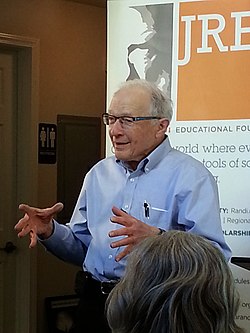Ray Hyman
[2] Hyman, along with James Randi, Martin Gardner and Paul Kurtz, is one of the founders of the modern skeptical movement.
[3] In his teenage years and later while attending Boston University,[3] he worked as a magician and mentalist,[4] impressing the head of his department (among others) with his palmistry.
Hyman replied that it began when he was hired as a magician at age 7 (as the "Merry Mystic") performing for the Parents and Teachers Association at his school.
The disclaimer is supposed to inform the audience that what they are witnessing is entertainment, and is not based on actual paranormal powers.
By openly stating that he made no claims about the nature of his ability, Hyman had given his audience no reason to challenge him.
In 2007 Hyman received an honorary doctorate from the Simon Fraser University for his "intellect and discipline who inspire others to follow in his footsteps... (and) for his courageous advocacy of unfettered skeptical inquiry".
[18] The guide exploits what fascinated him in his academic research in cognitive psychology, that much deception is self-deception.
[19] According to Bob Carroll, psychologist Ray Hyman is considered to be the foremost expert on subjective validation and cold reading.
[20] Hyman's prestidigitational skills (which he calls "manipulating perception") have earned him the cover of The Linking Ring twice, June 1952 and October 1986 this magazine of the International Brotherhood of Magicians of which he has been a member for over 35 years.
[23] He is working on two books: How Smart People Go Wrong: Cognition and Human Error and Parapsychology's Achilles' Heel: Consistent Inconsistency.
Grothe interview, Hyman states that the formation of the skeptic movement can be attributed to Uri Geller and Alice Cooper.
While there, "Randi pulled me aside and said... we really ought to do something about this Uri Geller business... lets form an organization called SIR" (Sanity In Research).
The three of them felt they had no administration experience, "we just had good ideas" and were soon joined by Marcello Truzzi who provided structure for the group.
[30][31] Speaking to a reporter from The Register-Guard Hyman explains that people come from all over the country to attend the 4-day conference, to hone their critical thinking skills.
[33] This approach differs from that of a traditional conference: he has attendees use hands-on participation, splitting them into teams so they are able to spend quality time discussing the readings and lectures.
[34] Hyman published his "classic paper showing that human choice reaction time is related to the information content of an incoming signal" called the Hick-Hyman Law.
He states that Hick used a different formula and got his "math wrong, which I corrected" but they still named the law after him because Hyman was "just a student".
He noted that the experiments "appear to be free of the more obvious and better known flaws that can invalidate the results of parapsychological investigations" and that there are significant effect sizes "too large and consistent to be dismissed as statistical flukes."
"[36] While working at Stanford University and serving as the "Spook Chair'" Hyman decided that he would never be able to read all the literature concerning parapsychology that existed in the 1980s.
[37]Magician Jerry Andrus and Hyman appeared in 1975 on a TV station in Portland, Oregon, where they explained and duplicated the "paranormal" tricks Geller had performed for host Dick Klinger the week prior.
Speaking as a psychologist Hyman says "If you get people in the right frame of mind and they are cooperating with you... and even give them a poor reading... they will fit it to themselves and believe you are telling them about their unique personality.
"[38] Gary Schwartz conducted numerous experiments at his laboratory at the University of Arizona where he is a tenured professor.
Hyman wrote "Even if the research program were not compromised by these defects, the claims being made would require replication by independent investigators."
Hyman criticizes Schwartz's decision to publish his results without gathering "evidence for their hypothesis that would meet generally accepted scientific criteria... they have lost credibility.
Hyman answered, "Until multiple perfect experiments are performed and published... believe that the totality of the findings must be due to some combination of fraud, cold reading, rater bias, experimenter error, or chance... Why spend the time and money conducting multiple multi-center, double-blind experiments unless there are sufficient theoretical, experimental, and social reasons for doing so?
Also on Squaring the Strange Podcast, Celestia Ward has called this the opposite of the Straw man fallacy, advising critics formulate responses to the strongest interpretation of the claimant's argument.





